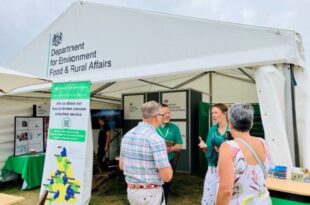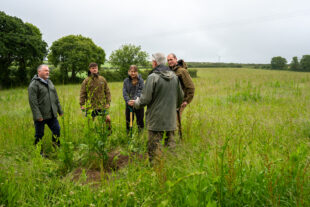https://defrafarming.blog.gov.uk/create-and-restore-species-rich-grassland/
Create and restore species-rich grassland
The guidance on this page is for SFI pilot participants only. Please visit GOV.UK for the official Sustainable Farming Incentive scheme guidance.
Find out how land managers can create and restore species rich grassland to benefit the environment.
If you’re completing this action as part of the Sustainable Farming Incentive pilot, how you do it is up to you.
The advice on this page can help you get better environmental and business benefits, but you do not have to follow it to get paid.
About species-rich grassland
Species-rich grassland is open, grassy habitat that is normally maintained by traditional grazing and cutting methods. A grassland is species-rich if it has:
- more than 15 plant species per square metre
- more than 30% cover of wildflowers and sedges (excluding white clover, creeping buttercup and injurious weeds)
- less than 10% cover of white clover and perennial rye grass
Each grassland has its own community of plant species, which can be grouped into different types. The type of species-rich grassland depends on location, underlying geology, soil pH, its management and history.
The different types of species-rich grassland are:
- lowland meadows
- upland hay meadows
- lowland calcareous grassland
- upland calcareous grassland
- lowland acid grassland
- purple moor-grass and rush pastures
- calaminarian grassland
Use MAGIC to check if you have species-rich grassland that’s mapped as priority habitat and what type of grassland it is. You can find some types of species-rich grassland alongside other habitats, like scrub, fen or heath.
Find out how to manage each type of species-rich grassland to create the best conditions for wildlife.
The benefits of creating or restoring species-rich grassland
Species-rich grassland is rare and home to a large number and variety of wildflowers. Each grassland supports a set of species, including many threatened species of plants, invertebrates and birds.
Species-rich grassland:
- keeps soil healthy and carbon-rich
- protects soil from erosion
- provides diverse forage for livestock
- is part of the character of a landscape
- can be part of our cultural heritage where traditions and skills are maintained, like haymaking
Creating or restoring species-rich grassland will provide more habitat and can:
- connect sites to other species-rich grassland or habitats, which allows wildlife to move across the landscape
- reduce the need for artificial fertiliser and pesticide
Before you start
Make sure you’ll be able to manage species-rich grassland once it has established. You need to graze, cut for hay or cut species-rich grassland to maintain the grassy vegetation.
Soil nutrient status
Any site you plan to create or restore should have low soil fertility. On fertile sites, competitive grasses dominate and smother wildflowers.
Before you create or restore, always assess your soil’s nutrient status. Soil phosphorous should be low, with an index of 0 or 1 or less than 16mg/l. If it’s higher, it’s likely that many wildflowers will be smothered by more competitive species.
Get advice from a trained ecologist if the soil phosphorous index is 2 or above. If it is, you’ll find it difficult to restore or create species-rich grassland.
Where to create species-rich grassland
You can create species-rich grassland on:
- arable land
- temporary grassland
You may be able to create species-rich grassland and maintain it as a habitat within new woodland creation projects.
Locations with the most potential:
- have few weeds like black-grass, couch grass or creeping thistle
- are where vegetation growth is stressed, such as on thin soil or soil affected by drought
On historic features, you’ll need to convert arable land to permanent grassland by sowing a seed mix. A seed mix establishes quickly and reduces the risk of soil erosion, which can damage the features. Register and request an SFI Historic Environment Farm Environment Record (SFI HEFER) to learn more about historic features on your land.
Do not convert arable land to grassland in areas that:
- contain rare arable wildflowers
- have populations of scarce farmland birds, like corn bunting or yellowhammer
Where to restore species-rich grassland
You can restore existing:
- priority habitat grassland that is in poor condition
- permanent grassland on infertile soil
Locations with the most potential:
- have few weeds like black-grass, couch grass or creeping thistle
- are where vegetation growth is stressed, like on thin drought-stressed soils
How to restore priority habitat grassland
To restore priority habitat grassland, you’ll need to introduce suitable management. It’s likely that it will be either undergrazed or overgrazed. You’ll need to manage each type of species-rich grassland differently to provide the best conditions for its plant community and other wildlife.
You may need to:
- remove scrub
- remove bracken
- manage weeds or invasive species
How to create or restore species-rich grassland
You can create species-rich grassland or add new wildflowers to infertile permanent grassland by:
- oversowing yellow rattle
- spreading green hay
- sowing seed
- plug planting
Using locally collected green hay or seed means the species in your grassland are local to your area. Green hay is cheaper than buying or collecting seeds, but it’s not always available and can make grassland take longer to establish.
You can sow a bought seed mix where local seed is not available. Seed mixes are suited to arable sites where large amounts of seed are needed to cover bare ground.
Do not sow a seed mix next to valuable botanical sites, such as Sites of Special Scientific Interest (SSSI). This can cause cross-pollination of sown species with natural plant communities. Seeds should be of UK native species. You must make sure these are certified seeds from a licenced supplier, even if you use locally sourced seed or green hay.
You can use natural regeneration, but you’ll usually need to add species with one of the other methods. Natural regeneration takes much longer than other methods but helps preserve the local distinctiveness of grasslands. It’s more suited to making existing grassland more diverse than creating new species-rich grassland.
Natural regeneration will only work if the recipient site is next to an existing species-rich grassland. You’ll need direct access for livestock between them.
How to prepare arable land
Create a well-consolidated, firm, fine, level and weed-free seedbed to improve germination. This is also the most effective weed and slug control.
You can use min-till or no-till to sow seed. This can help retain soil organic matter and reduce soil erosion risk.
How to prepare existing grassland
Cut or graze the existing vegetation very short and create at least 50% bare ground in June to mid-July. Remove any cuttings.
You can create bare ground using livestock, or machinery like a set of discs or chain harrow. Wildflower seeds need to touch bare ground to germinate.
Remove livestock in very wet weather or if they are poaching the soil. Do not supplementary feed livestock as this can prevent them from grazing the grass.
Suitable sites have few weeds, but they may have some. They’re easier to control before you add species. You should manage weeds to low levels before you cultivate or create bare ground.
Find out if you need to manage rushes or bracken before adding new species.
Oversowing yellow rattle
Yellow rattle is a native annual wildflower. It’s semi-parasitic on nearby grasses and legumes. It reduces the vigour and biomass of grasses and legumes. This allows a wider range of wildflowers to flourish as grass species are less able to dominate.
Introducing yellow rattle is useful where the soil is more fertile, and grasses are dominant.
In cases where soil nutrients prevent creation or restoration of species-rich grassland, plant or sow wildflowers that tolerate higher nutrient status. These may provide new pollen and nectar sources for a greater range of insects. Yellow rattle can be especially good at increasing the cover of wildflowers in these situations and where you manage grassland as a hay meadow.
Using green hay
Green hay is wildflowers and grasses harvested just as they are shedding seed. This hay is spread onto a recipient site, allowing the seed to drop and germinate.
Find out how to collect green hay.
Donor and recipient sites must be close together as you’ll need to collect, transport and spread the hay in no more than half a day. If green hay is kept longer it heats up, which can make the seed infertile.
You’ll need green hay from 1 hectare (ha) to restore approximately 3ha. Make sure the donor site is big enough to supply the recipient site.
Spread green hay using a muck spreader, or by hand on smaller areas. Make sure the hay is spread thinly and evenly.
After spreading green hay, roll or tread in seed with livestock. Wildflower and grass seeds need to touch the soil to germinate. Remove livestock within 5 days to stop damage to new seedlings.
Graze or cut in the first autumn after spreading green hay. Aim for a sward height of 3cm to 5cm up to the first spring after spreading. This will provide light and space for seeds to germinate.
Sowing seeds
You can sow locally harvested seed or a bought seed mix.
Your seed supplier can help you choose a seed mix and seed rate to best match your soil type and local conditions.
The best time to spread seed is from late July to mid-September. This is when most grassland plants shed. You can also spread the seed in March and April.
Seeds germinate best when scattered on the surface. Scatter seeds evenly onto bare ground.
You can use a modified seed hopper to scatter seeds on larger fields. If you’re using brush-harvested seed, you can use extra agitators. Brush-harvested seed can have lots of extra material, such as stalks and leaves, which can clog up the machine.
You can also spread seed by hand. Mix seed with dry sand to help bulk it out.
Roll after sowing to keep in moisture and ensure good seed-to-soil contact. Wildflower and grass seeds need to touch the soil to germinate.
Graze or cut in the first autumn after sowing seed. This keeps grass short and reduces competition for emerging wildflowers from grasses.
Using plug plants
Plants grown in pots or plugs can be a good way to supplement other methods of sward enhancement. This method is good for adding wildflowers which are hard to germinate. You can also use it to plant species that provide food for invertebrates.
Not all grassland is suitable for plug planting. It should only be used as a supplementary method of sward enhancement. Plug planting is usually more expensive and time consuming than other methods.
If you need a large number of species, you may want to set up a contract with a nursery to grow plug plants from seed.
Plug plants are a good choice for:
- bugle
- harebell
- cuckoo flower
- dropwort
- meadow cranes bill
- wood cranes bill



